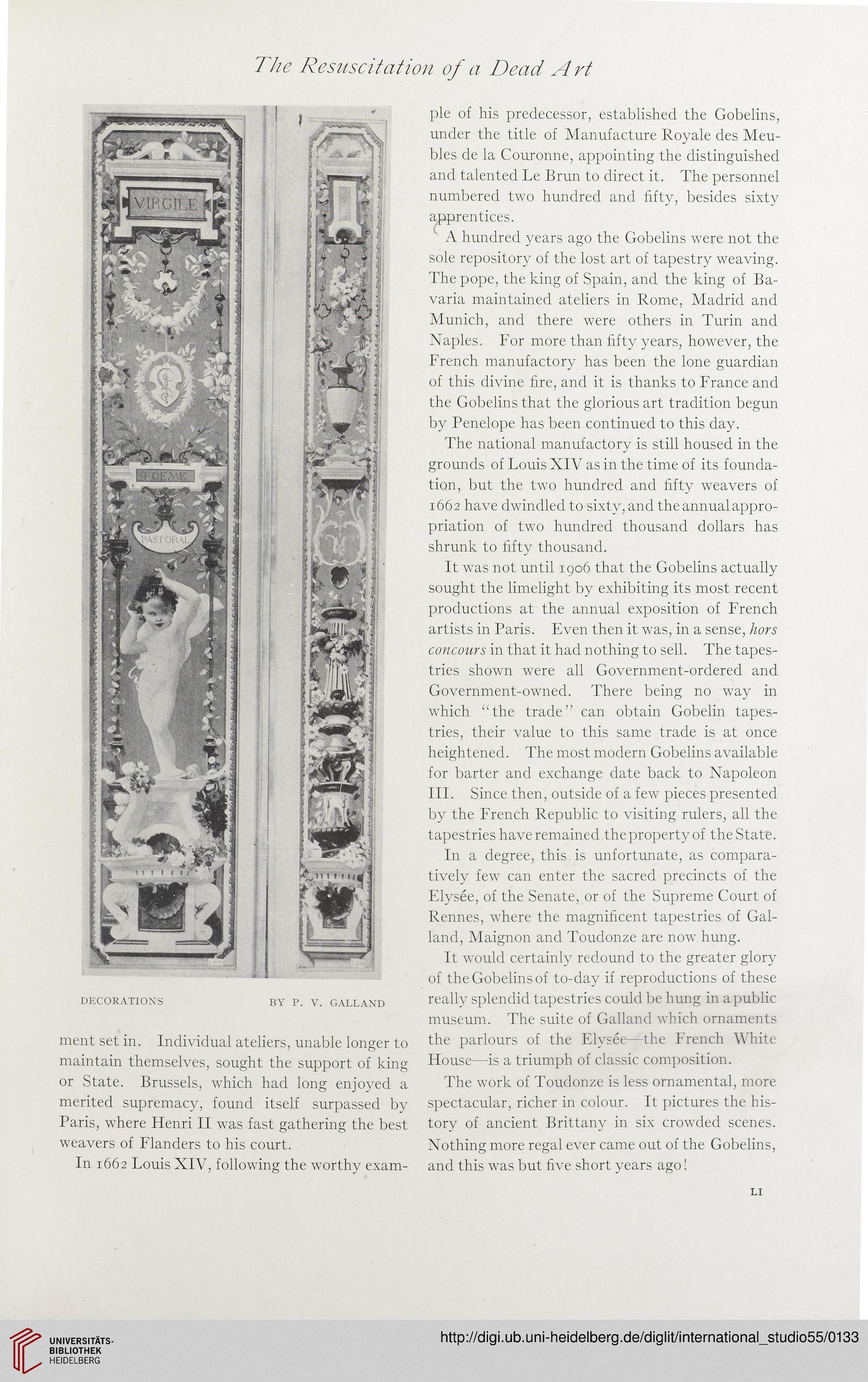The Resuscitation of a Dead Art
DECORATIONS
BY P. V. GALLAND
ment set in. Individual ateliers, unable longer to
maintain themselves, sought the support of king
or State. Brussels, which had long enjoyed a
merited supremacy, found itself surpassed by
Paris, where Henri II was fast gathering the best
weavers of Flanders to his court.
In 1662 Louis XIV, following the worthy exam-
ple of his predecessor, established the Gobelins,
under the title of Manufacture Royale des Meu-
bles de la Couronne, appointing the distinguished
and talented Le Brun to direct it. The personnel
numbered two hundred and fifty, besides sixty
apprentices.
A hundred years ago the Gobelins were not the
sole repository of the lost art of tapestry weaving.
The pope, the king of Spain, and the king of Ba-
varia maintained ateliers in Rome, Madrid and
Munich, and there were others in Turin and
Naples. For more than fifty years, however, the
French manufactory has been the lone guardian
of this divine fire, and it is thanks to France and
the Gobelins that the glorious art tradition begun
by Penelope has been continued to this day.
The national manufactory is still housed in the
grounds of Louis XIV as in the time of its founda-
tion, but the two hundred and fifty weavers of
1662 have dwindled to sixty, and the annual appro-
priation of two hundred thousand dollars has
shrunk to fifty thousand.
It was not until 1906 that the Gobelins actually
sought the limelight by exhibiting its most recent
productions at the annual exposition of French
artists in Paris. Even then it was, in a sense, hors
cone ours in that it had nothing to sell. The tapes-
tries shown were all Government-ordered and
Government-owned. There being no way in
which “the trade” can obtain Gobelin tapes-
tries, their value to this same trade is at once
heightened. The most modern Gobelins available
for barter and exchange date back to Napoleon
III. Since then, outside of a few pieces presented
by the French Republic to visiting rulers, all the
tapestries have remained the property of the State.
In a degree, this is unfortunate, as compara-
tively few can enter the sacred precincts of the
Elysee, of the Senate, or of the Supreme Court of
Rennes, where the magnificent tapestries of Gal-
land, Maignon and Toudonze are now hung.
It would certainly redound to the greater glory
of the Gobelins of to-day if reproductions of these
really splendid tapestries could be hung in a public
museum. The suite of Galland which ornaments
the parlours of the Elysee—the French White
House—is a triumph of classic composition.
The work of Toudonze is less ornamental, more
spectacular, richer in colour. It pictures the his-
tory of ancient Brittany in six crowded scenes.
Nothing more regal ever came out of the Gobelins,
and this was but five short years ago!
LI
DECORATIONS
BY P. V. GALLAND
ment set in. Individual ateliers, unable longer to
maintain themselves, sought the support of king
or State. Brussels, which had long enjoyed a
merited supremacy, found itself surpassed by
Paris, where Henri II was fast gathering the best
weavers of Flanders to his court.
In 1662 Louis XIV, following the worthy exam-
ple of his predecessor, established the Gobelins,
under the title of Manufacture Royale des Meu-
bles de la Couronne, appointing the distinguished
and talented Le Brun to direct it. The personnel
numbered two hundred and fifty, besides sixty
apprentices.
A hundred years ago the Gobelins were not the
sole repository of the lost art of tapestry weaving.
The pope, the king of Spain, and the king of Ba-
varia maintained ateliers in Rome, Madrid and
Munich, and there were others in Turin and
Naples. For more than fifty years, however, the
French manufactory has been the lone guardian
of this divine fire, and it is thanks to France and
the Gobelins that the glorious art tradition begun
by Penelope has been continued to this day.
The national manufactory is still housed in the
grounds of Louis XIV as in the time of its founda-
tion, but the two hundred and fifty weavers of
1662 have dwindled to sixty, and the annual appro-
priation of two hundred thousand dollars has
shrunk to fifty thousand.
It was not until 1906 that the Gobelins actually
sought the limelight by exhibiting its most recent
productions at the annual exposition of French
artists in Paris. Even then it was, in a sense, hors
cone ours in that it had nothing to sell. The tapes-
tries shown were all Government-ordered and
Government-owned. There being no way in
which “the trade” can obtain Gobelin tapes-
tries, their value to this same trade is at once
heightened. The most modern Gobelins available
for barter and exchange date back to Napoleon
III. Since then, outside of a few pieces presented
by the French Republic to visiting rulers, all the
tapestries have remained the property of the State.
In a degree, this is unfortunate, as compara-
tively few can enter the sacred precincts of the
Elysee, of the Senate, or of the Supreme Court of
Rennes, where the magnificent tapestries of Gal-
land, Maignon and Toudonze are now hung.
It would certainly redound to the greater glory
of the Gobelins of to-day if reproductions of these
really splendid tapestries could be hung in a public
museum. The suite of Galland which ornaments
the parlours of the Elysee—the French White
House—is a triumph of classic composition.
The work of Toudonze is less ornamental, more
spectacular, richer in colour. It pictures the his-
tory of ancient Brittany in six crowded scenes.
Nothing more regal ever came out of the Gobelins,
and this was but five short years ago!
LI




